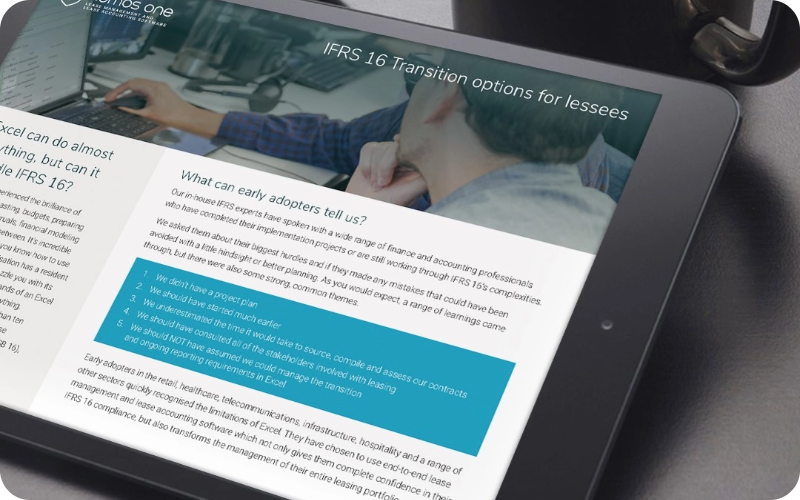Navigating lease accounting regulations is essential for businesses to ensure compliance, accurate financial reporting, and risk mitigation. This article provides insights and strategies to help businesses navigate lease accounting compliance with confidence.
Understanding lease accounting standards
The IFRS 16 (AASB 16) lease accounting standard, introduced by the International Accounting Standards Board (IASB), has fundamentally changed how businesses report their leases on financial statements. IFRS 16 mandates that all leases be recognised on the balance sheet, with certain exceptions. This shift from treating operating leases as off-balance-sheet items to recognising lease liabilities and right-of-use (ROU) assets aims to increase transparency and comparability of financial statements.

The key requirements of the standard include:
- Recognition of lease liabilities and right-of-use assets. Companies must record a lease liability representing future lease payments and a corresponding right-of-use asset reflecting their right to use the leased asset.
- Enhanced disclosure requirements. Detailed information about leasing arrangements, including the nature, amount, timing, and uncertainty of lease payments, must be disclosed.
These changes impact not only the balance sheet but also the income statement, where lease expenses are split between depreciation of the ROU asset and interest on the lease liability. Understanding these aspects is crucial for businesses to align their lease accounting practices with the new standards.
Impact of lease accounting changes
The transition to IFRS 16 has significant implications for financial statements, key financial ratios, and performance metrics. For instance, including leases on balance sheets increases assets and liabilities, which can alter leverage ratios and return on assets (ROA), potentially impacting perceptions of a company’s financial health. This can affect covenants and may require renegotiation of terms with lenders.
Implementing IFRS 16 standards also presents challenges, such as identifying all lease agreements or accurately measuring lease liabilities. One significant challenge is gathering and maintaining accurate lease data across the organisation, which can be incredibly complex for companies with extensive lease portfolios. Another challenge is correctly determining the lease term, discount rates, and variable lease payments, which involves substantial judgement. Finally, the company’s existing accounting systems and processes may require significant updates to accommodate the evolving standards. Businesses must carefully manage these complexities by establishing the right systems and processes to handle ongoing accounting requirements, avoid compliance risks, and ensure accurate financial reporting.

Adopting robust lease management practices
Robust lease management practices are essential for facilitating lease accounting compliance. Effective lease data management involves maintaining a comprehensive and accurate lease inventory, which includes key terms, conditions, and payment schedules.
Best practices for lease management include:
- Accurate classification of leases. Ensure leases are correctly classified as either operating or finance leases.
- Lease data centralisation. Consolidate lease information in a centralised database to facilitate accurate tracking and reporting. Continuously update lease data to reflect changes in lease terms, payments, or other relevant factors.
- Accurate measurement. Calculate lease liabilities and right-of-use assets accurately, considering all relevant factors such as lease term, discount rates, and variable payments.
- Consistent accounting policies. Develop and apply consistent accounting policies to ensure uniformity in lease accounting practices across the organisation.
- Internal controls. Maintaining thorough documentation and implementing strong internal controls to support lease accounting entries and disclosures.
Leveraging technology solutions
Technology solutions pare pivotal in streamlining lease administration and simplifying compliance with accounting regulations. Lease accounting software, like Nomos One, offers advanced features to automate lease accounting processes, from initial recognition to subsequent measurement and reporting. Automating the calculation of lease liabilities and right-of-use assets allows finance teams to save time while reducing manual errors. Additionally, it provides comprehensive analytics and reporting that help gain insights into lease portfolios and generate timely financial reports. It also supports ongoing compliance with lease accounting standards through automated alerts and regular updates.

Ongoing monitoring and review
Lease accounting compliance is an ongoing process requiring regular lease agreement monitoring and reviews. Periodic lease portfolio audits and assessments can help identify potential areas of non-compliance and address any issues proactively. Businesses should establish procedures for continuous review and update of lease terms, ensuring that any changes are reflected in the financial statements.
Navigating lease accounting regulations with confidence requires a thorough understanding of lease accounting standards. By implementing proactive strategies and staying abreast of regulatory updates, businesses can ensure compliance, mitigate risks, and maintain financial integrity.
Stay ahead of lease accounting regulations and ensure your business remains compliant with the latest standards with our comprehensive guide on IFRS 16. Check it out now!

























